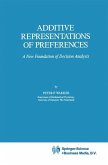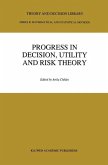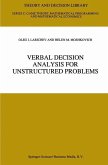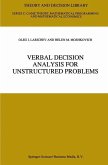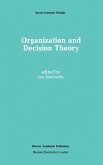0. Elementary Definitions.- I. From Choice Functions to Binary Relations.- II. Cartesian Product Structure.- III. Additive Representations.- IV. Continuous Subjective Expected Utility.- V. Continuous Subjective Expected Utility for Arbitrary State Spaces.- VI. Subjective Expected Utility with Nonadditive Probabilities.- VII. Concavity on Mixture Spaces and Risk Aversion.- A1. Generalizations of midpoint convexity.- A2. Classical representations of seu-maximization.- A3. Further remarks.- Reference-Footnotes.- Reference-footnotes to Chapter I.- Reference-footnotes to Chapter II.- Reference-footnotes to Chapter III.- Reference-footnotes to Chapter IV.- Reference-footnotes to Chapter V.- Reference-footnotes to Chapter VI.- Reference-footnotes to Chapter VII.- Reference-footnotes to the Appendix.- References.- Author Index.- Notation Index.
Hinweis: Dieser Artikel kann nur an eine deutsche Lieferadresse ausgeliefert werden.
Hinweis: Dieser Artikel kann nur an eine deutsche Lieferadresse ausgeliefert werden.
`This book represents a very real and important contribution to the mathematics of decision theory. The distinguishing feature of Wakker's approach is that he has no need of a reference experiment. There are further results aplenty and much for the decision theorist to ponder. These results will also help psychologists, economists and others formulate and test models of decision-making behaviour. By any standards its publication is a landmark ... excellent survey and summary of the literature on additive preference models. Each page represents the distillation of much thought. As a consequence, it is a book that rewards reading and rereading. Wakker's results and methods of proof will enlighten research into decision theory for many years.' British Journal of Mathematical and Statistical Psychology, 43, 1990
`This book represents a very real and important contribution to the mathematics of decision theory.
The distinguishing feature of Wakker's approach is that he has no need of a reference experiment.
There are further results aplenty and much for the decision theorist to ponder. These results will also help psychologists, economists and others formulate and test models of decision-making behaviour.
By any standards its publication is a landmark ... excellent survey and summary of the literature on additive preference models. Each page represents the distillation of much thought. As a consequence, it is a book that rewards reading and rereading. Wakker's results and methods of proof will enlighten research into decision theory for many years.'
British Journal of Mathematical and Statistical Psychology, 43, 1990
The distinguishing feature of Wakker's approach is that he has no need of a reference experiment.
There are further results aplenty and much for the decision theorist to ponder. These results will also help psychologists, economists and others formulate and test models of decision-making behaviour.
By any standards its publication is a landmark ... excellent survey and summary of the literature on additive preference models. Each page represents the distillation of much thought. As a consequence, it is a book that rewards reading and rereading. Wakker's results and methods of proof will enlighten research into decision theory for many years.'
British Journal of Mathematical and Statistical Psychology, 43, 1990


